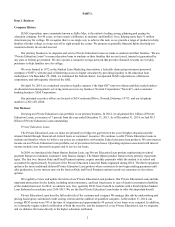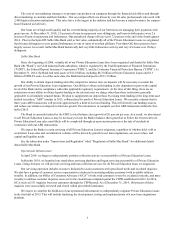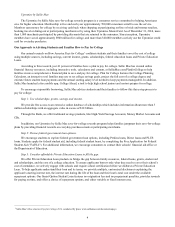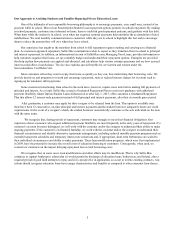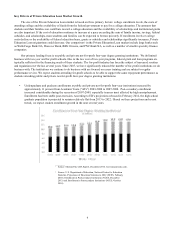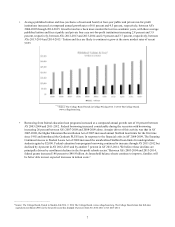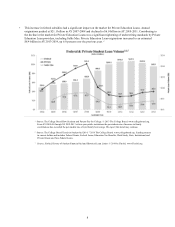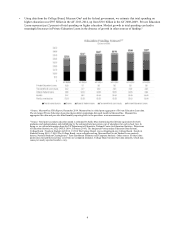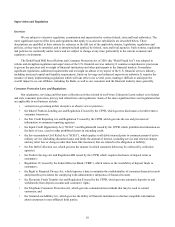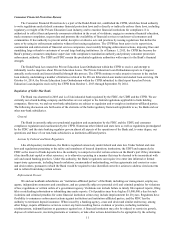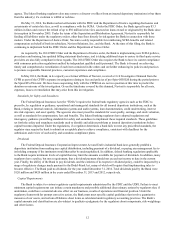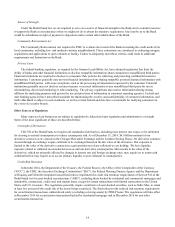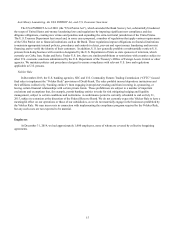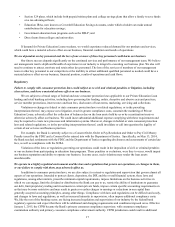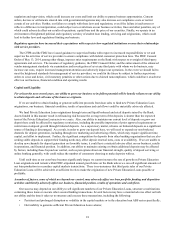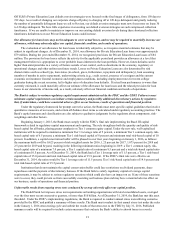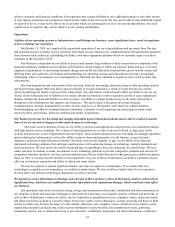Sallie Mae 2014 Annual Report Download - page 14
Download and view the complete annual report
Please find page 14 of the 2014 Sallie Mae annual report below. You can navigate through the pages in the report by either clicking on the pages listed below, or by using the keyword search tool below to find specific information within the annual report.agency. The federal banking regulators also may remove a director or officer from an insured depository institution (or bar them
from the industry) if a violation is willful or reckless.
On May 13, 2014, the Bank reached settlements with the FDIC and the Department of Justice regarding disclosures and
assessments of certain late fees, as well as compliance with the SCRA. Under the FDIC Order, the Bank agreed to pay $3.3
million in fines and oversee the refund of up to $30 million in late fees assessed on loans owned or originated by the Bank since
its inception in November 2005. Under the terms of the Separation and Distribution Agreement, Navient is responsible for
funding all liabilities under the regulatory orders, other than fines directly levied against the Bank in connection with these
matters. Under the Department of Justice Order, Navient is solely responsible for reimbursing SCRA benefits and related
compensation on behalf of both its subsidiary, Navient Solutions, Inc., and the Bank. At the time of this filing, the Bank is
continuing to implement both the FDIC Order and the Department of Justice Order.
As required by the 2014 FDIC Order and the Department of Justice order, the Bank is implementing new SCRA policies,
procedures and training, has updated billing statement disclosures, and is taking additional steps to ensure its third-party service
providers are also fully compliant in these regards. The 2014 FDIC Order also requires the Bank to have its current compliance
with consumer protection regulations audited by independent qualified audit personnel. The Bank is focused on achieving
timely and comprehensive remediation of each item contained in the orders and on further enhancing its policies and practices
to promote responsible financial practices, customer experience and compliance.
In May 2014, the Bank, in its capacity as a former affiliate of Navient, received a Civil Investigative Demand from the
CFPB as part of the CFPB’s separate investigation relating to fees and policies of pre-Spin-Off SLM during the period prior to
the Spin-Off of Navient. We have been cooperating fully with the CFPB but are not in a position at this time to predict the
duration or outcome of the investigation. Given the timeframe covered by this demand, Navient is responsible for all costs,
expenses, losses or remediation that may arise from this investigation.
Standards for Safety and Soundness
The Federal Deposit Insurance Act (the “FDIA”) requires the federal bank regulatory agencies such as the FDIC to
prescribe, by regulation or guidance, operational and managerial standards for all insured depository institutions, such as the
Bank, relating to internal controls, information systems and audit systems, loan documentation, credit underwriting, interest
rate risk exposure, and asset quality. The agencies also must prescribe standards for asset quality, earnings, and stock valuation,
as well as standards for compensation, fees and benefits. The federal banking regulators have adopted regulations and
interagency guidance prescribing standards for safety and soundness to implement these required standards. These guidelines
set forth the safety and soundness standards used to identify and address problems at insured depository institutions before
capital becomes impaired. Under the regulations, if a regulator determines a bank fails to meet any prescribed standards, the
regulator may require the bank to submit an acceptable plan to achieve compliance, consistent with deadlines for the
submission and review of such safety and soundness compliance plans.
Dividends
The Federal Deposit Insurance Corporation Improvement Act and Utah’s industrial bank laws generally prohibit a
depository institution from making any capital distribution, including payment of a dividend, or paying any management fee to
its holding company if the institution would thereafter be undercapitalized. In addition, federal banking regulations applicable
to the Bank require minimum levels of capital that may limit the amounts available for payment of dividends. In addition, many
regulators have a policy, but not a requirement, that a dividend payment should not exceed net income to date in the current
year. Finally, the ability of the Bank to pay dividends, and the contents of its respective dividend policy, could be impacted by a
range of regulatory changes made pursuant to the Dodd-Frank Act, many of which will require final implementing rules to
become effective. The Bank paid no dividends for the year ended December 31, 2014. Total dividends paid by the Bank were
$120 million and $420 million in the years ended December 31, 2013 and 2012, respectively.
Capital Requirements
The Bank is subject to various regulatory capital requirements administered by the FDIC and the UDFI. Failure to meet
minimum capital requirements can initiate certain mandatory and possibly additional discretionary actions by regulators that, if
undertaken, could have a material adverse effect on our business, results of operations and financial position. Under the
regulatory framework for prompt corrective action, the Bank must meet specific capital guidelines that involve quantitative
measures of our assets, and certain off-balance sheet items as calculated under regulatory accounting practices. The Bank’s
capital amounts and classification are also subject to qualitative judgments by the regulators about components, risk-weightings
and other factors.
12


